
The sitar is a plucked stringed instrument, originating from the Indian subcontinent, used in Hindustani classical music. The instrument was invented in medieval India, flourished in the 18th century, and arrived at its present form in 19th-century India. Khusrau Khan, an 18th-century figure of the Mughal Empire has been identified by modern scholarship as the inventor of the sitar. According to most historians, he developed the sitar from the setar, an Iranian instrument of Abbasid or Safavid origin. Another view supported by a minority of scholars is that Khusrau Khan developed it from Veena.

The hurdy-gurdy is a string instrument that produces sound by a hand-crank-turned, rosined wheel rubbing against the strings. The wheel functions much like a violin bow, and single notes played on the instrument sound similar to those of a violin. Melodies are played on a keyboard that presses tangents—small wedges, typically made of wood or metal—against one or more of the strings to change their pitch. Like most other acoustic stringed instruments, it has a sound board and hollow cavity to make the vibration of the strings audible.
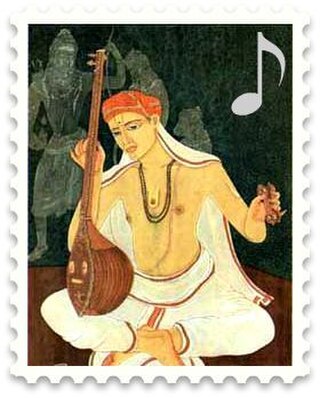
Indian classical music is the classical music of the Indian subcontinent. It is generally described using terms like Marg Sangeet and Shastriya Sangeet. It has two major traditions: the North Indian classical music known as Hindustani and the South Indian expression known as Carnatic. These traditions were not distinct until about the 15th century. During the period of Mughal rule of the Indian subcontinent, the traditions separated and evolved into distinct forms. Hindustani music emphasizes improvisation and exploration of all aspects of a raga, while Carnatic performances tend to be short composition-based. However, the two systems continue to have more common features than differences. Another unique classical music tradition from Eastern part of India, i. e. Odissi music has evolved since two thousand years ago.

The tanpura is a long-necked, plucked, four-stringed instrument originating in India, found in various forms in Indian music. Visually, the tanpura resembles a simplified sitar or similar lute-like instrument, and is likewise crafted out of a gourd or pumpkin.
Hindustani classical music is the classical music of the Indian subcontinent's northern regions. It may also be called North Indian classical music or, in Hindustani, shastriya sangeet. The term shastriya sangeet literally means classical music, and is also used to refer to Indian classical music in general. It is played on instruments like the veena, sitar and sarod. Its origins from the 12th century CE, when it diverged from Carnatic music, the classical tradition in South India. While Carnatic music largely uses compositions written in Kannada, Telugu, Tamil, Malayalam and sometimes in Sanskrit, Hindustani music largely uses compositions written in Urdu, Punjabi, Rajasthani and sometimes in Hindi.

A shruti box is an instrument, originating from the Indian subcontinent, that traditionally works on a system of bellows. It is similar to a harmonium and is used to provide a drone in a practice session or concert of Indian classical music. It is used as an accompaniment to other instruments and notably the flute. The shruti box is also used in classical singing. In classical singing, the shruti box is used to help tune the voice. The use of the shruti box has widened with the cross-cultural influences of world music and new-age music to provide a drone for many other instruments as well as vocalists and mantra singing.
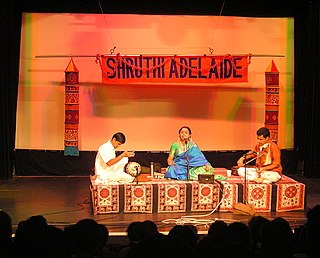
The shruti or śruti is the smallest interval of pitch that the human ear can detect and a singer or musical instrument can produce. The concept is found in ancient and medieval Sanskrit texts such as the Natya Shastra, the Dattilam, the Brihaddeshi, and the Sangita Ratnakara. Chandogya Upanishad speaks of the division of the octave in 22 parts.
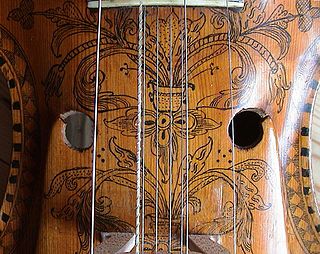
Sympathetic strings or resonance strings are auxiliary strings found on many Indian musical instruments, as well as some Western Baroque instruments and a variety of folk instruments. They are typically not played directly by the performer, only indirectly through the tones that are played on the main strings, based on the principle of sympathetic resonance. The resonance is most often heard when the fundamental frequency of the string is in unison or an octave lower or higher than the catalyst note, although it can occur for other intervals, such as a fifth, with less effect.
In music, a drone is a harmonic or monophonic effect or accompaniment where a note or chord is continuously sounded throughout most or all of a piece. A drone may also be any part of a musical instrument used to produce this effect; an archaic term for this is burden such as a "drone [pipe] of a bagpipe", the pedal point in an organ, or the lowest course of a lute. Α burden is also part of a song that is repeated at the end of each stanza, such as the chorus or refrain.

Raga rock is rock or pop music with a pronounced Indian influence, either in its construction, its timbre, or its use of Indian musical instruments, such as the sitar, tambura, and tabla. The term "raga" refers to the specific melodic modes used in Indian classical music.

The Sarasvatī vīṇa is an ancient Indian plucked veena. It is named after the Hindu goddess Saraswati, who is usually depicted holding or playing the instrument. Also known as raghunatha veena, it is used mostly in Carnatic Indian classical music. There are several variations of the veena, which in its South Indian form is a member of the lute family. One who plays the veena is referred to as a vaiṇika.
Svara is a word that connotes simultaneously a breath, a vowel, the sound of a musical note corresponding to its name, and the successive steps of the octave or saptaka. More comprehensively, it is the ancient Indian concept about the complete dimension of musical pitch. Most of the time a svara is identified as both musical note and tone, but a tone is a precise substitute for sur, related to tunefulness. Traditionally, Indians have just seven svaras/notes with short names, e.g. saa, re/ri, ga, ma, pa, dha, ni which Indian musicians collectively designate as saptak or saptaka. It is one of the reasons why svara is considered a symbolic expression for the number seven.

In Indian classical music, javārī refers to the overtone-rich "buzzing" sound characteristic of classical Indian string instruments such as the tanpura, sitar, surbahar, rudra veena and Sarasvati veena. Javari can refer to the acoustic phenomenon itself, or to the meticulously carved bone, ivory or wooden bridges that support the strings on the sounding board and produce this particular effect. A similar sort of bridge is used on traditional Ethiopian lyres, as well as on the ancient Greek kithara, and the "bray pins" of some early European harps operated on the same principle. A similar sound effect, called sawari, is used on some traditional Japanese instruments as well.
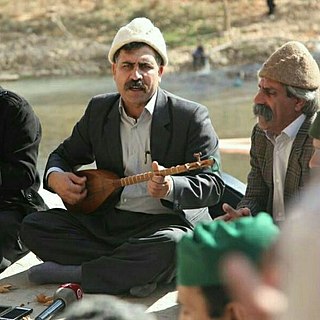
The term Tanbur can refer to various long-necked string instruments originating in Mesopotamia, Southern or Central Asia. According to the New Grove Dictionary of Music and Musicians, "terminology presents a complicated situation. Nowadays the term tanbur is applied to a variety of distinct and related long-necked lutes used in art and folk traditions. Similar or identical instruments are also known by other terms." These instruments are used in the traditional music of Iran, India, Kurdistan, Armenia, Afghanistan, Azerbaijan, Pakistan, Turkey, Tajikistan, Kazakhstan, and Uzbekistan.

Carnatic music is usually performed by a small ensemble of musicians, who sit on an elevated stage. This usually consists of at least; a principal performer, a melodic accompaniment, a rhythm accompaniment, and a drone.
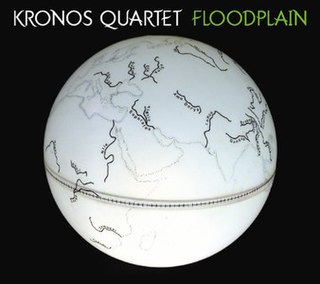
Floodplain is a studio album by the Kronos Quartet released in 2009. All twelve compositions were written or arranged for the quartet.

Rag Shankara, Rag Mala in Jogia is a studio album by Indian classical musician Ram Narayan, released in 1990. Recorded on 15 and 16 November 1989 in Wyastone Leys near Monmouth, Wales, the album features a sarangi performance of the solemn night ragaShankara and a ragamala based on the introspective early morning ragaJogiya. On both tracks, Narayan performs a long non-metrical introduction to unfold the raga, during which he adds a pulse, until he is joined by the tabla (percussion) player to perform a composition.

The veena, also spelled vina, is any of various chordophone instruments from the Indian subcontinent. Ancient musical instruments evolved into many variations, such as lutes, zithers and arched harps. The many regional designs have different names such as the Rudra veena, the Saraswati veena, the Vichitra veena and others.
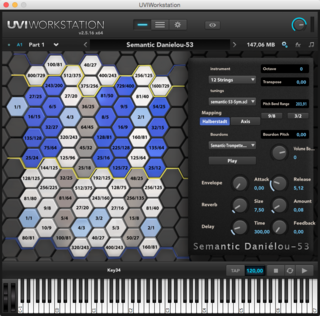
The semantic system is based on a microtonal musical scale tuned in just intonation, developed by Alain Daniélou.

The Indian harmonium,hand harmonium,samvadini, peti ("box"), or vaja, often just called a harmonium, is a small and portable hand-pumped reed organ which is very popular in the Indian subcontinent. The sound resembles an accordion or other bellows driven free-reed aerophones.
















